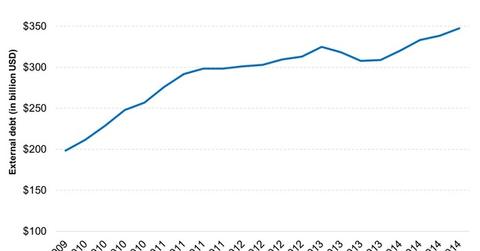Why the Brazilian Government’s Debt Has Surged over the Years
The Brazilian government’s debt has surged over the last five years. The country’s internal debt has also increased.
March 25 2015, Updated 11:06 a.m. ET

Debt.
Consumers, as well as the government, are borrowing more amid weakened economic conditions. Gross debt for Brazil is now around 64% of its gross domestic product. The burden is even more problematic if you consider the country’s high interest rates—the policy rate was just raised to 12.75%, one of the highest among major economies—which dramatically increase the costs of servicing debt. The credit rating on national champion oil producer Petrobras (PBR) was recently lowered to junk status, adding to investor worries that Brazil’s sovereign debt will suffer the same fate.
Corruption.
An ongoing bribery investigation centered around Petrobras was yet another pain point. In recent weeks, the scandal has ensnared more politicians with allegations now reaching senior members of Congress. As the Petrobras scandal worsens, both stocks and bonds have sold off, with 10-year rates climbing back up to record levels.
Market Realist – The Brazilian government’s debt has surged over the last five years.
The graph above shows the Brazilian Government’s external debt since the last quarter of 2009. Its debt grew from ~$198 billion to ~$347 billion in the last quarter of 2014. This is a compound annual growth rate of 15.1%, which is much higher than the growth in Brazil’s GDP. So Brazil’s external debt led to the country’s higher percentage of external debt to GDP.
The country’s internal debt has also increased, leading to a total debt-to-GDP ratio of 63.4% in December 2014. The Central Bank of Brazil expects this ratio to increase to 65.2% by the end of the year. This is one of the highest ratios among major emerging markets (EEM)(VWO). China (FXI) and Russia (RSX) have done a good job checking their own ratios, keeping their ratios at ~13% and ~22% of GDP, respectively—though both countries have other significant issues to deal with. While developed markets (EFA) in general have some of the world’s highest debt-to-GDP ratios, it’s normal for these economies’ debt-to-GDP ratios to be close to 100%.
